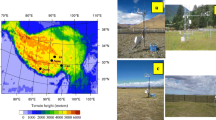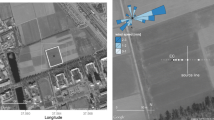Abstract
Representative source area of turbulent fluxes measured by eddy covariance stations is an important issue which has not yet been fully investigated. In particular, the validation of the analytical footprint models is generally based on the comparison with Lagrangian model predictions, while experimental results are not largely diffused in literature. In this work, spatial distribution of carbon dioxide, latent and sensible heat fluxes across two different maize fields in Po Valley, is used to validate two theoretical footprint models. Experiments are performed in two totally different scenarios at bare and vegetated soils using two eddy covariance systems: one fixed station which is located about in the middle of the field and a mobile station which is placed at various distances from the field edge to investigate the horizontal variation of the vertical scalar fluxes. The first objective of this work is to provide detailed information about the spatial distribution of turbulent fluxes across Po Valley characteristic fields at bare and vegetated soils, highlighting peculiarities and uniqueness. The second objective consists in the comparison between mobile measurements of carbon dioxide, latent and sensible heat fluxes and the predictions of two analytical footprint models widely used in literature. Contemporaneously, the latter objective will permit to understand what is the best footprint model which, under typical Po Valley atmospheric turbulent conditions, describes a representative source area compatible with the field dimensions and the turbulent flux distributions. The results show that both models are in good agreement with experimental measurements. The results also show that the spatial distribution of turbulent fluxes is strongly influenced by the presence of vegetation in the field. Moreover, the representative source area is different for different scalar fluxes. Another result is about 10:1 fetch-to-height obtained for both field situations.






Similar content being viewed by others
References
Aubinet M, Grelle A, Ibrom A et al (2000) Estimates of the annual net carbon and water exchange of forests: the euroflux methodology. Adv Ecol Res 30:113–175
Baldocchi D (2003) Assessing the eddy covariance technique for evaluating carbon dioxide exchange rates of ecosystems: past, present and future. Glob Change Biol 9:1–14
Baldocchi D, Rao K (1995) Intra-field variability of scalar flux densities across a transition between desert and an irrigated potato field. Bound Lay Meteorol 76:109–136
Baldocchi D, Hicks BB, Meyers TP (1988) Measuring biosphere atmosphere exchange of biologically related gases with micrometeorological methods. Ecology 69:1331–1340
Baldocchi D, Falge E, Gu L, Olsen R, Hollinger D, Running S et al (2001) FLUXNET: a new tool to study the temporal and spatial variability of ecosystem scale carbon dioxide, water vapor, and energy flux densities. B Am Meteorol Soc 82:2415–2434
Calder K (1952) Some recent british work on the problem of diffusion in the lower atmosphere. Mc Graw-Hill, New York, pp 787–792
Castaldelli G, Colombani N, Vincenzi F, Mastrociccio M (2013) Linking dissolved organic carbon, acetate and denitrification in agricultural soils. Environ Earth Sci 68:939–945
Corbari C, Masseroni D, Mancini M (2012) Effetto delle correzioni dei dati misurati da stazioni eddy covariance sulla stima dei flussi evapotraspirativi. Ital J Agrometeorol 1:35–51
Dyer AJ (1963) The adjustment of profiles and eddy fluxes. Quart J Roy Meteorol Soc 89:276–280
Elliot W (1958) The growth of the atmospheric internal boundary layer. Trans Am Geophys Un 50:171–203
Foken T (2008) The energy balance closure problem:an overview. Ecol Appl 18:1351–1367
Foken T, Leclerc MY (2004) Methods and limitations in validation of footprint models. Agr Forest Meteorol 127:223–234
Foken T, Wichura B (1996) Tools for quality assessment of surface-based flux measurements. Agr Forest Meteorol 78:83–105
Foken T, Göckede M, Mauder M, Mahrt L, Amiro B, Munger J (2004) Post-field data quality control. In: Lee X, Massman W, Law B (eds) Handbook of micrometeorology: A guide for surface flux measurement and analysis. Kluwer, Dordrecht, pp 181–208. doi:10.1007/1-4020-2265-4_9
Foken T, Wimmer F, Mauder M, Thomas C, Liebhetal C (2006) Some aspects of the energy balance closure problem. Atmos Chem Phys 6:4395–4402
Garratt J (1993) The atmospheric boundary layer. Cambridge university press, Cambridge, p 316 (ISBN 0 521 38052 9)
Gash JHC (1986) A note on estimating the effect of a limited fetch on micrometeorological evaporation measurements. Bound Lay Meteorol 35:409–413
Göckede M, Markkanen T, Mauder M, Arnold K, Leps J-P, Foken T (2005) Validation of footprint models using natural tracer measurements from a field experiment. Agr Forest Meteorol 135:314–325
Horst T (1999) The footprint for estimation of atmosphere surface exchange fluxes by profile techniques. Bound Lay Meteorol 90:171–188
Horst T, Weil J (1992) Footprint estimation for scalar flux measuraments in the atmospheric sourface layer. Bound Lay Meteorol 59:279–296
Hsieh C, Katul (2009) The Lagrangian stochastic model for estimating footprint and water vapor fluxes over inhomogeneous surfaces. Int J Biometeorol 53:87–100
Hsieh C, Katul G, Chi T (2000) An approximate analytical model for footprint estimation of scalar fluxes in thermally stratified atmospheric flows. Adv Water Res 23:765–772
Kaimal JC, Finnigan JJ (1994) Atmospheric boundary layer flows, their structure and measurement. Oxford University Press, New York, p 289
Kljun N, Rotach M, Schmid H (2002) A 3D bacward lagrangian footprint model for a wide range of buondary layer stratifications. Bound Lay Meteorol 103:205–226
Kljun N, Kastner-Klein P, Fedorovich E, Rotach MW (2004) Evaluation of a lagrangian footprint model using data from a wind tunnel convective boundary layer. Special issue on footprints of fluxes and concentrations. Agr Forest Meteorol 127:189–201
Kormann R, Meixner F (2001) An analytical model for non-neutral stratification. Bound Lay Meteorol 103:205–224
Kurbanmuradov OA, Sabelfeld KK (2000) Lagrangian stochastic models for turbulent dispersion in the atmospheric boundary layer. Bound Lay Meteorol 97:191–218
Leclerc MY, Meskhidze N, Finn D (2003) Comparison between measured tracer fluxes and footprint model predictions over a homogeneous canopy of intermediate roughness. Agr Forest Meteorol 117:145–158
Lee X (2002) Fetch and footprint of turbulent fluxes over vegetative stands with elevated sources. Bound Lay Meteorol 107:561–579
Marcolla B, Cescatti A (2005) Experimental analysis of flux footprint for varying stability conditions in an alpine meadow. Agr Forest Meteorol 135:291–301
Masseroni D, Ravazzani G, Corbari C, Mancini M (2012) Turbulance integral length and footprint dimension with reference to experimental data measured over maize cultivation in Po Valley, Italy. Atmosfera 25:183–198
Mauder M, Foken T (2004) Documentation and instruction manual of the eddy covariance software package TK2, vol 26. Univ Bayreuth, Abt Mikrometeorol, Arbeitsergebn, pp 42
Moncrieff J, Clement R, Finnigan J, Meyers T (2004) Averanging and filtering of eddy covariance time series. In: Handbook of micrometeorology: a guide for surface flux measurements. Kluwer Academic, Dordrecht, pp 7–31
Munro DS, Oke TR (1975) Aerodynamic Boundary-Layer adjustment over a crop in neutral stability. Bound Lay Meteorol 9:53–61
Neftel A, Spirig C, Ammann C (2008) Application and test of a simple tool for operational footprint evaluations. Environ Pollut 152:644–652
Papale D, Reichstein M, Aubinet M, Canfora E, Bernhofer C, Kutsch W et al (2006) Towards a standardized processing of net ecosystem exchange measured with eddy covariance technique: algorithms and uncertainty estimation. Biogeosciences 3:571–583
Pasquill F, Smith FB (1983) Atmospheric diffusion, 3rd edn. Wiley, New York, p 437
Rannik U, Aubinet M, Kurbanmuradov O, Sabelfeld KK, Markkanen T, Vesala T (2000) Footprint analysis for measurements over a heterogeneous forest. Bound Lay Meteorol 97:137–166
Raupach MR (1989) A practical lagrangian method for relating Scalar concentrations to source distributions in vegetation canopies. Quart J Roy Meteorol Soc 115:609–632
Savelyev S, Taylor P (2005) Internal Boundary Layer: I. Height formulae for neutral and diabatic flows. Bound Lay Meteorol 115:1–25
Schmid H (1994) Source areas for scalars and scalar fluxes. Bound Lay Meteorol 67:293–318
Schmid H (1997) Experimental design for flux measurements: matching scales of observations and fluxes. Agr Foest Meteorol 87:179–200
Schmid H (2002) Footprint modeling for vegetation atmosphere exchange studies: a review and prospective. Agr Foest Meteorol 113:159–183
Schuepp P, Leclerc M, Macpherson J, Desjardins R (1990) Footprint prediction of scalar fluxes from analytical solutions of the diffusion equation. Bound Lay Meteorol 50:353–373
Thomson D (1987) Criteria for the selection of stochastic models of particle trajectories in turbolent flows. J Fluid Mech 180:529–556
Tsai J, Tsuang B (2005) Aerodinamic roughness over an urban area and over two farmalands in a populated area as determined by wind profiles and surface energy flux measurements. Agric Forest Meteorol 132:154–170
Van de Boer A, Moene AF, Schuttemeyer D, Graf A (2013) Sensitivity and uncertainty of analytical footprint models according to a combined natural tracer and ensemble approach. Agr Forest Meteorol 13:1–11
Van Dijk A, Kohsiek W, De Bruin H (2003) Oxygen sensitivity of krypton and Lyman-alfa Hygrometer. J Atmos Ocean Tech 20:143–151
Van Ulden A (1978) Simple estimates for vertical diffusion from cources near the ground. Atmos Environ 12:2125–2129
Vesala T, Kljun N, Rannik U, Rinne J, Sogachev A, Markkanen T, Sabelfeld K, Foken T, Leclerc MY (2008) Flux and concentration footprint modeling: State of the art. Environ Pollut 152:653–666
Webb E, Pearman G, Leuning R (1980) Correction of the flux measurements for density effects due to heat and water vapour transfer. Bound Lay Meteorol 23:251–254
Acknowledgments
This work was funded in the framework of the ACQWA EU/FP7 project (Grant number 212250) “Assessing Climate impacts on the Quantity and quality of WAter”, the framework of the ACCA project funded by Regione Lombardia “Misura e modellazione matematica dei flussi di ACqua e CArbonio negli agro-ecosistemi a mais” and PREGI (Previsione meteo idrologica per la gestione irrigua) funded by Regione Lombardia. The authors thank the University of Milan–DISAA for the collaboration in managing Landriano eddy covariance station. Special thanks to Dr. Alessandro Ceppi for his help in setting up the experiment and his overall support.
Author information
Authors and Affiliations
Corresponding author
Rights and permissions
About this article
Cite this article
Masseroni, D., Corbari, C. & Mancini, M. Validation of theoretical footprint models using experimental measurements of turbulent fluxes over maize fields in Po Valley. Environ Earth Sci 72, 1213–1225 (2014). https://doi.org/10.1007/s12665-013-3040-5
Received:
Accepted:
Published:
Issue Date:
DOI: https://doi.org/10.1007/s12665-013-3040-5




